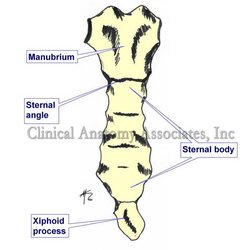

Sternum, anterior view
UPDATED:The sternal angle is the term used to denote the angulation at the joint between the manubrium and the body of the sternum. This transverse joint is called the "manubriosternal joint" and is a secondary cartilaginous joint of a type known as a symphysis. The angle varies between 160 and 169 degrees.
It is know eponymously as the "angle of Louis" named after Antoine Louis 1 (1723-1792), a French physician. The importance of the sternal angle is that of an anatomical superficial landmark, which forms a horizontal plane which indicates a series of anatomical occurrences, as follows:
• Location of the cartilages of the second rib
• Beginning and end of the aortic arch
• Boundary between the inferior and superior mediastinum
• Location of the bifurcation of the trachea
• Posteriorly, the plane of the sternal angle passes trough the T4-T5 intervertebral disc (sometimes a little lower, through the superior aspect of T5)
• Highest point of the pericardial sac.
• It is the point where the right and left pleurae meet in the midline. They touch, but their pleural spaces do not communicate (usually).
1. Some authors contest the eponym, adjudicating it to Pierre Charles Alexander Louis (1787-1872), another French physician.
Image property of: CAA.Inc.. Artist: David M. Klein
Thoracic anatomy, pathology and surgery, are some of the many lecture topics developed and presented by Clinical Anatomy Associates, Inc. For more information Contact Us.
Medical Terminology Daily (MTD) is a blog sponsored by Clinical Anatomy Associates, Inc. as a service to the medical community, medical students, and the medical industry. We will post a workweek daily medical or surgical term, its meaning and usage, as well as biographical notes on anatomists, surgeons, and researchers through the ages. Be warned that some of the images used depict human anatomical specimens.
Click on the link below to subscribe to the MTD newsletter. If you think an article could be interesting to somebody else, click on the mail link at the top of each article to forward it.
You are welcome to submit questions and suggestions using our "Contact Us" form. The information on this blog follows the terms on our "Privacy and Security Statement" and cannot be construed as medical guidance or instructions for treatment.